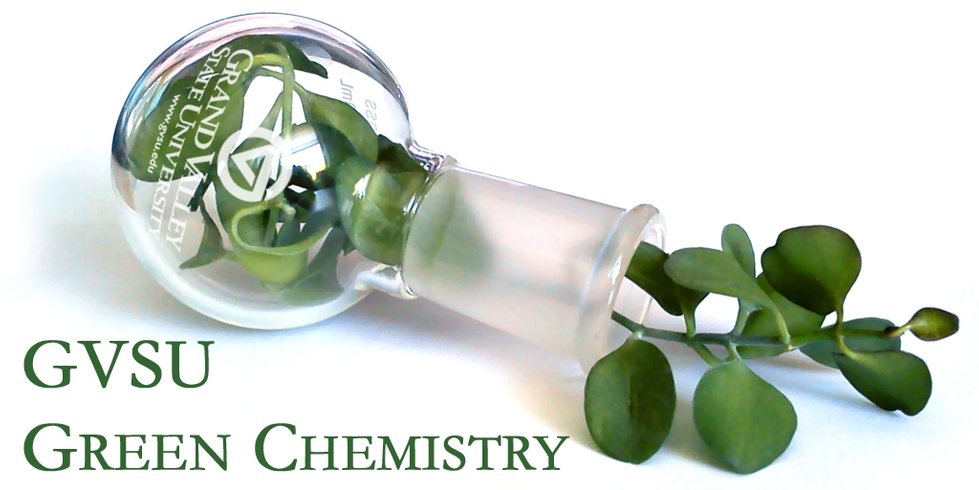Green Chemistry at GVSU
According to the American Chemical Society, "sustainable and green chemistry in very simple terms is just a different way of thinking about how chemistry and chemical engineering can be done. Over the years different principles have been proposed that can be used when thinking about the design, development and implementation of chemical products and processes. These principles enable scientists and engineers to protect and benefit the economy, people and the planet by finding creative and innovative ways to reduce waste, conserve energy, and discover replacements for hazardous substances."
The American Chemical Society Committee on Professional Training has recommendations for the inclusion of Green Chemistry principles in the curriculum of Chemistry and Biochemistry majors

The Green Chemistry Commitment
As a signer of the Green Chemistry Commitment, GVSU Chemistry department agrees to work towards adopting the GCC Student Learning Objectives in our own unique way. Upon graduation, we believe all chemistry majors should have proficiency in the following essential green chemistry competencies:
Theory: working knowledge of the Twelve Principles of Green Chemistry.
Toxicology: understanding of the principles of toxicology, the molecular mechanisms of how chemicals affect human health and the environment, and the resources to identify and assess molecular hazards.
Laboratory Skills: possess the ability to assess chemical products and processes and design greener alternatives when appropriate.
Application: be prepared to serve society in their professional capacity as scientists and professionals through the articulation, evaluation, and employment of methods and chemicals that are benign for human health and the environment.
GVSU courses with Green Chemistry content
CHM 421 Green Chemistry For Sustainable Environment Credits: 3
Practical aspects of environmental and health issues are discussed following the principles of green chemistry. Environmental chemistry methods, application of green chemistry, benign design, and lifecycle analysis, through experimental design secure fundamental understanding of methodologies used in environmental laboratories and applications of green chemistry. Three hours of lecture per week. Course offered fall semester. Prerequisite: One of CHM 231, CHM 242, or CHM 247.
CHM 427 Green and Environmental Chemistry Laboratory Credits: 3
Students are exposed to the methods used in environmental chemistry analysis and the application of green chemistry principles, benign design, life cycle analysis through experimental design, practical aspects of environmental, and human health issues. A solid understanding of methodology used in environmental laboratories and application of green chemistry is attained. Course offered winter semester. Prerequisites: CHM 221; CHM 241, or CHM 245 and CHM 246.
CHM 442 Synthetic Polymers: Life Cycle and Emerging Sustainable Technologies Credits: 3
Synthetic and analytical approaches to polymer and materials development using the principles of green chemistry. Coverage of how chemists incorporate principles of green chemistry and sustainable technologies into their workflow to assess the life cycles of polymers and materials. Three hours of lecture per week. Offered winter semester of even-numbered years. Prerequisite: CHM 242 or CHM 247.
CHM 111 Introduction to Green Chemistry Credits: 3
Green chemistry, also known as sustainable chemistry, is the design of chemical products and processes that reduce or eliminate the use or generation of hazardous substances. The course presents basic concepts of green chemistry and engineering. It is not applicable for chemistry majors or minors. Fulfills Foundations - Physical Sciences.
CHM 380 Introduction to Contemporary Toxicology Credits: 3
A multidisciplinary overview of the toxic effects of chemicals on human health and environment, public policies, and the development of less hazardous alternatives through chemical design. The course focuses on assessments, mechanisms, properties, health effects, and strategies to reduce risk and exposure in everyday life across diverse societal groups.
